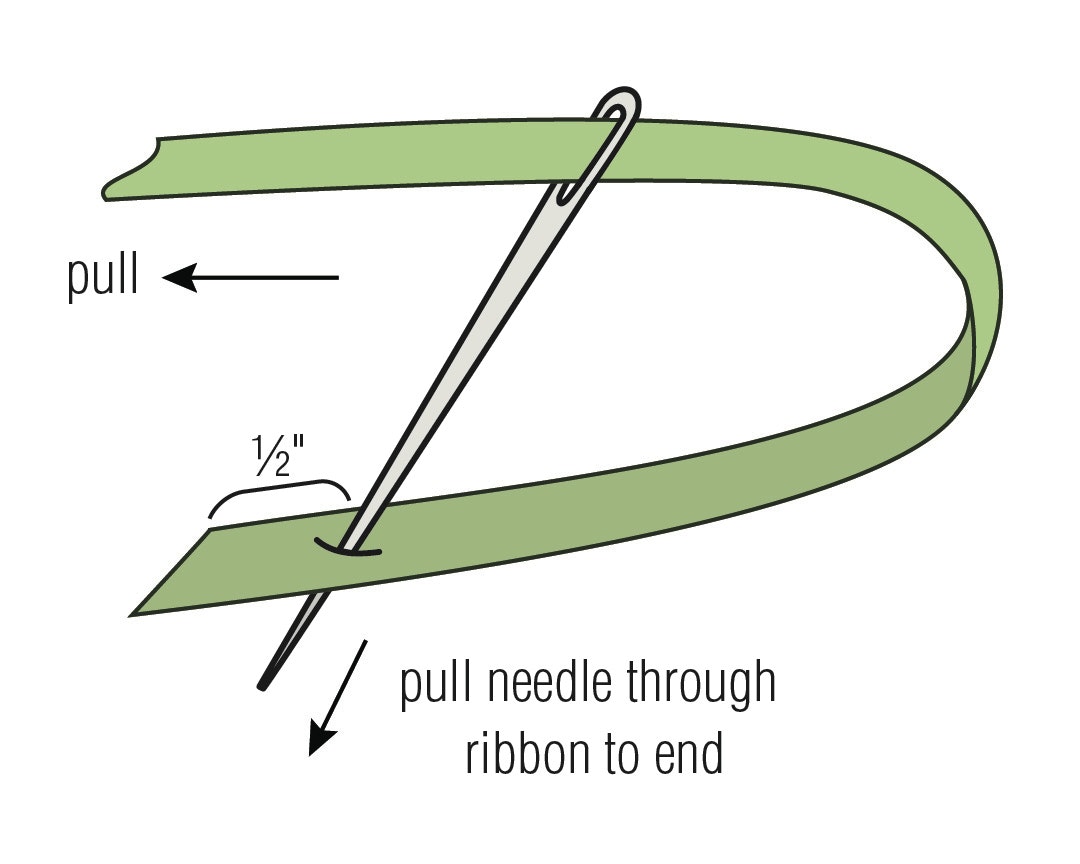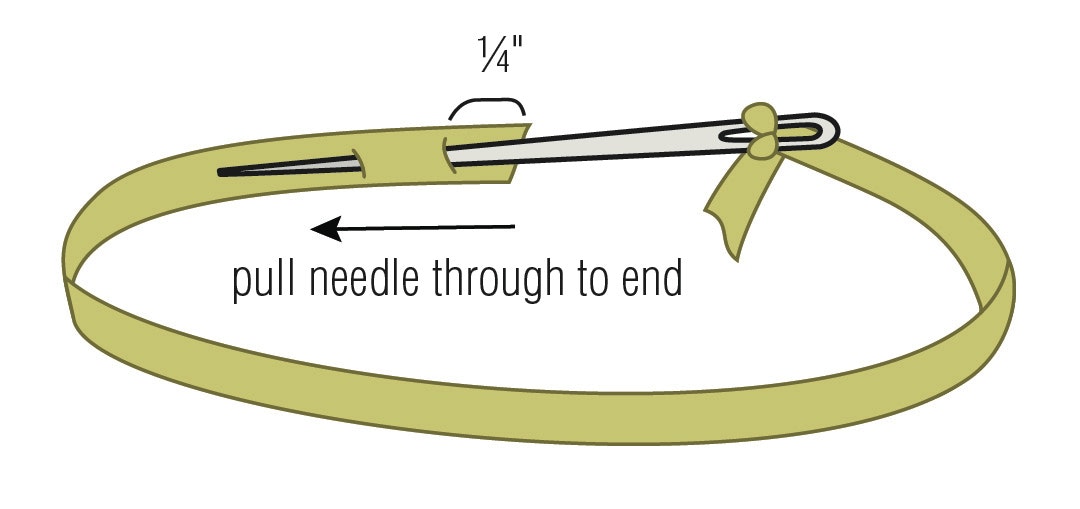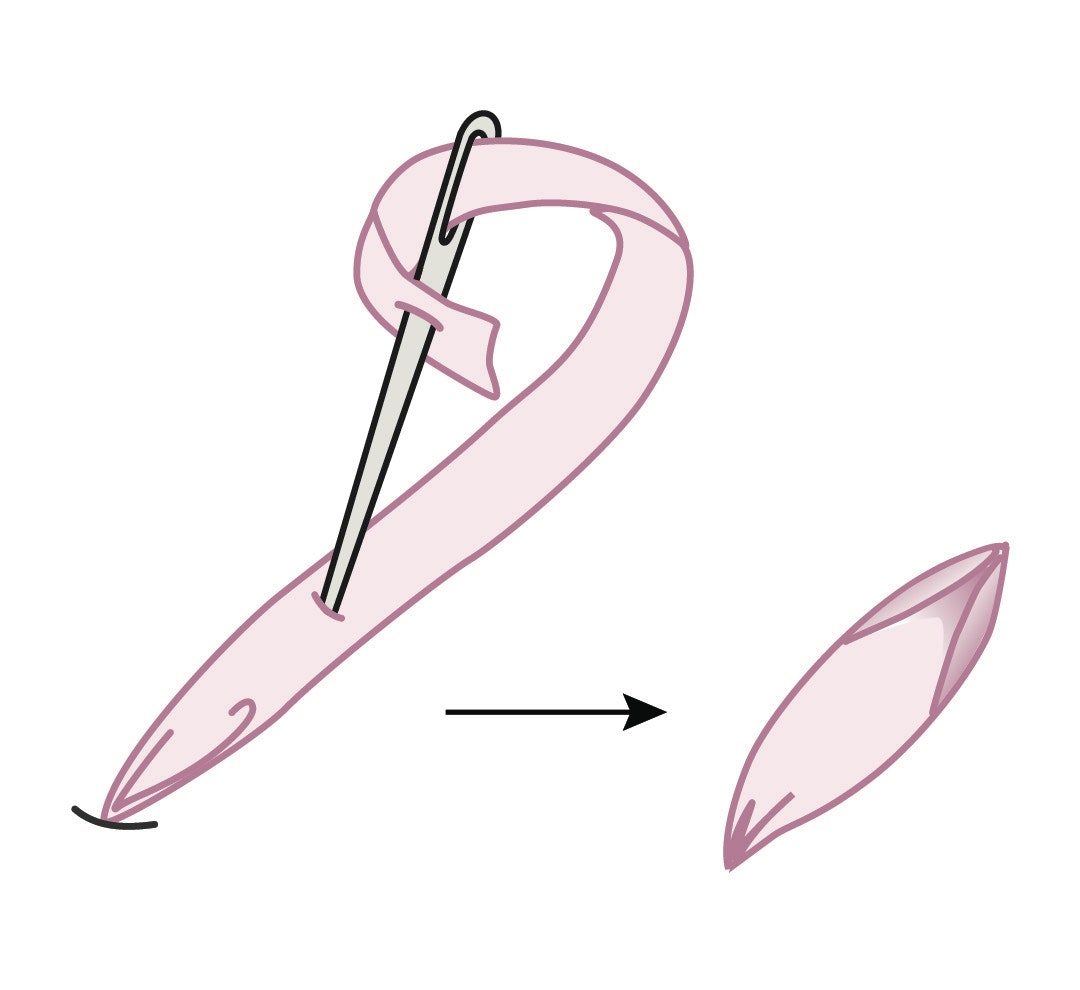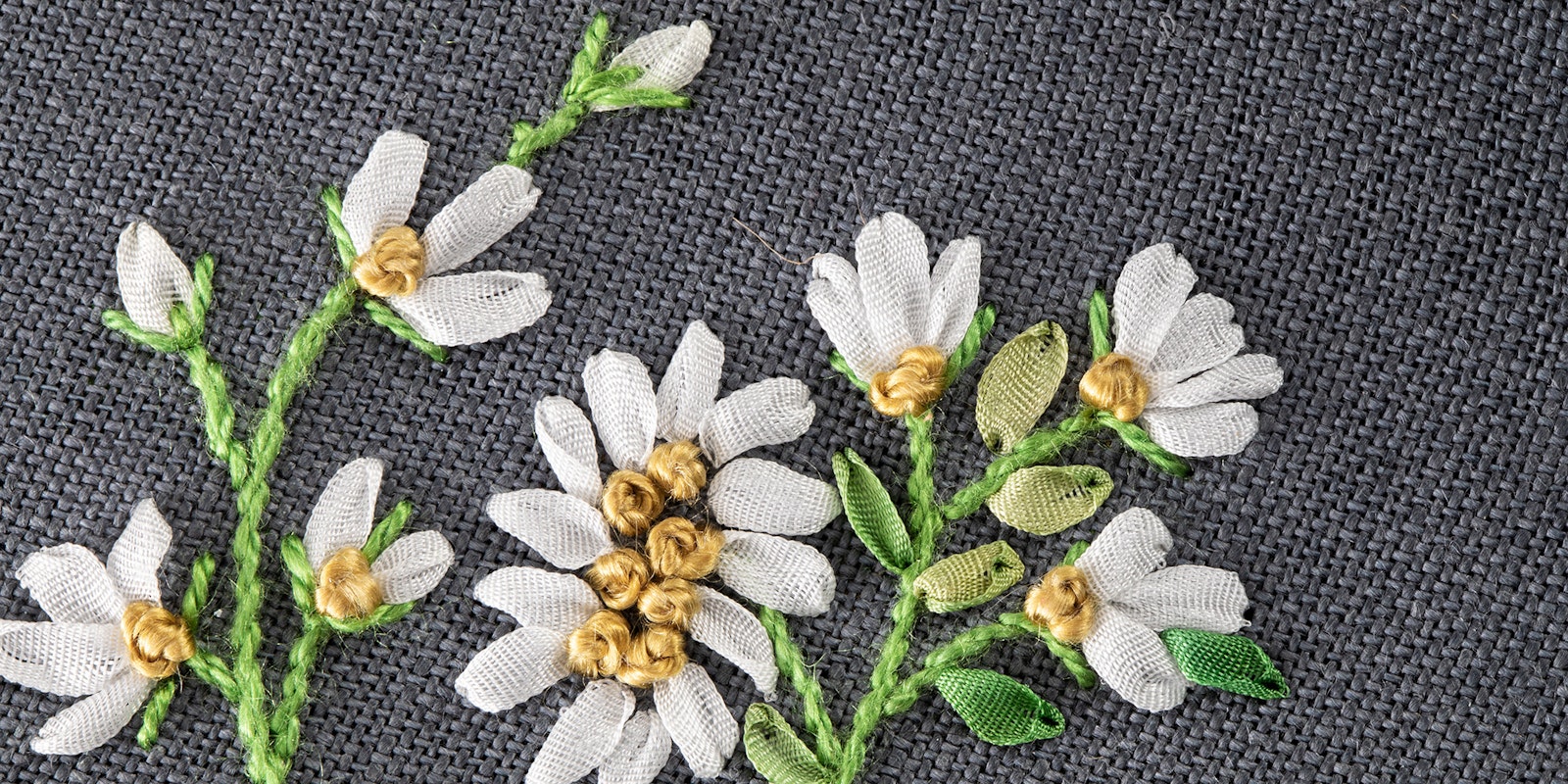A Silk-Ribbon Embroidery Primer
The silk ribbon that is used for embroidery is a soft, 100% silk, woven-edge ribbon that generally comes in three sizes, approximately 2, 3.5–4, and 7 mm widths, and in many different colors and styles (solid, overdyed, hand-painted, and hand-dyed). Silk-ribbon embroidery can be used beautifully with other types of surface embroidery threads (cotton or silk floss, pearl-type and metallic threads), techniques (stumpwork, hardanger, needlepoint), with added accoutrements (charms, beads), and even on fabric-painted backgrounds. It is so versatile!
Appropriate Background Fabrics
Almost any type of fabric is suitable for silk-ribbon embroidery—cotton, polyester, wool, knits, silks, linen, velvet, denim, felt, and even knitted/crocheted items. Avoid very densely woven fabrics. If you can successfully pull a needle through the fabric without damaging the ribbon, then you can probably use it. However, give it a trial run first. If the silk ribbon looks like it is crushed as it emerges from the fabric, choose the next size larger chenille needle with its wider barrel to see if that solves the problem.
For very lightweight fabrics, use a lightweight iron-on interfacing on the back of the fabric to hold the weight of the ribbon stitches and prevent the fabric between the design elements from drooping.
Generally, do not prewash the fabric because sizing helps for better stitching results. Of course, there are always exceptions, I always wash clothing and block knitted and crocheted items before stitching on them.
Transfer the Design
There are multiple methods and products which could be used to transfer a design to the background fabric.
The easiest and most common way to transfer a design onto light-to-medium-colored background fabrics is to use a window or light box. Secure the design, tape the fabric over the design, and trace it with a lead or marking pencil.
For dark fabrics the process is a little more complicated. First, trace the design onto a sheet of white printer or typing paper. Using painter’s tape, firmly tape the fabric to a hard, flat surface (such as a table), then center and tape the dressmakers carbon paper to the fabric. Finally, center and tape the traced design paper over the carbon paper. Using a blunt awl, size #18 tapestry needle, or empty ballpoint pen, firmly trace over the design. This transfers the design to the fabric. If the design is faint, enhance it by using a fine-point quilter’s pencil with white lead.
Prepare the Silk Ribbon
Remove the ribbon from its original packaging and roll it onto an empty sewing-thread spool, the inner cardboard roll from paper towels or bath tissue, or around short 1" (2.5 cm) diameter wooden dowels. The latter three cylindrical items need to be covered with acid-free tissue paper to prevent the silk ribbon from discoloring over time.
Cut short lengths of ribbon 8"–12" (20.3–30.5 cm) long and always at a sharp angle to prevent excessive raveling. Iron out any wrinkles and folds with an iron set on a low setting for silk products or run the short ribbon length quickly through a heated hair curling or straightening iron on a low heat setting. You can also very slightly dampen the silk ribbon with a barely moistened sponge to remove the wrinkles, but note that the ribbon must be thoroughly dry before stitching.
Choose the Correct Needle Type and Size
The width of the ribbon determines the size of the needle. The needle needs to be large enough to create a hole in the fabric for the silk ribbon to easily pass through without being crushed or damaged. With 3.5 mm and 7 mm wide ribbon, use a size 18 or 20 chenille needle and for 2 mm width use a size 20 chenille needle.
If the silk-ribbon embroidery is to be stitched on an evenweave fabric, then you can use a tapestry needle. (A tapestry needle is just a blunt-ended chenille needle.) For the larger-sized silk thread (such as Serenity by Treenway Silks) or size 5 pearl cotton, use a chenille size 20 or 22. For the smaller sized silk thread (such as Zen Shin by Treenway Silks) or size 8 or 12 pearl cotton, use a crewel/embroidery needle size 5 or 6.
Use a quilting or between needle in size 10 with sewing thread to tack down the ending lengths of the ribbon. The quilting needle is better to use than a sharps needle because it is shorter and less likely to accidentally pierce the already formed ribbon stitches.
Thread the Needle and Secure the Ribbon
If you have trouble threading the ribbon or silk thread through the needle, use a flat metal hook needle threader that fits into the eye of the needle. This type of threader will not damage the thread or ribbon in the way that a wire threader might.
Use the following special method to secure the ribbon length into the needle. Thread one end of the ribbon through the needle’s eye for 3"–4" (7.6–10.2 cm), pierce the ribbon with the needle’s tip about ½" (1.3 cm) from the short end, and pull on the longer length to form wthe ribbon around the needle’s eye. This prevents the ribbon from slipping out of the needle while stitching.
 Anchoring the ribbon in the needle
Anchoring the ribbon in the needle
When you are finished embroidering with a piece of ribbon, create an ending knot in this manner: pierce the remaining ribbon end ¼" (0.6 cm) from the end, sew a ¼" (0.6 cm) running stitch, and then pull the ribbon through these folds to create a loose knot at the opposite end.
 Ending a ribbon
Ending a ribbon
Thread each ribbon and thread color used in the design into a separate appropriately sized needle. Park each prepared needle in a pincushion ready for use. Having a dedicated needle for each ribbon and thread color creates an easier, faster, more convenient, and less wasteful way to stitch. This way also lets you easily use up those short lengths of ribbon that always seem to occur.
Stitching Technique
Silk-ribbon stitchery should almost always be on fabric under taut tension, which requires a spring tension or regular hoop, snap frame, stretcher bars for embroidery, or roller frame that is only about 1" (2.5 cm) larger on all sides than the design. Of course, any of these devices can be used with a floor, table, or lap stand, allowing both hands free to stitch and arrange the ribbon. I much prefer a spring tension hoop or a snap frame that lets me more easily manipulate the ribbon as needed.
Using large safety pins, pin the excess fabric around the hoop or frame out of the way to avoid stitching into this fabric. Do not crush already formed stitches by placing any of these stitching aids on already formed silk ribbon stitches.
For most designs, stitch the background elements such as stems and branches first, and then the silk-ribbon components. Once those are complete, you may stitch any remaining design components. For the best results, pull the ribbon straight up from the ground fabric, sew the stitch, and then go straight down into the fabric to finish it. Starting at the top of a design normally avoids messing up already stitched ribbon elements. Do not pull the stitches too tightly on the front or back. Let the ribbon gently puff and drape to create a more natural appearance for the petals and leaves.
Stitching with silk ribbon employs basically the same embroidery stitches as other types of surface embroidery. However, there are a few special stitches that are unique to silk ribbon, such as the ribbon stitch (a.k.a. the Japanese ribbon stitch), the loop, twisted-ribbon variations, plume, and a few other stitches.
 The ribbon stitch
The ribbon stitch
Many books about silk-ribbon embroidery advocate ending the ribbon stitches with a knot. I have never found this to be very successful because almost always this results in pulled or otherwise distorted surface stitches. Use the sewing thread and small sharp needle to tack down the ribbon tails to previously formed stitches or to the stitch just created.
Controlling the Ribbon
Silk-ribbon embroidery is not fast. Most of the time is spent manipulating the ribbon so that you achieve the desired results. Use a blunt awl, a large tapestry needle, tweezers, or the flat side of embroidery scissors to stroke, position, arrange, and rearrange the ribbon into place and for best appearance.
Take the time to ensure that the ribbon emerges from the back of the fabric as flat as possible and then make it flare out to its fullest width by stroking the ribbon. If the ribbon emerges from the fabric twisted, cut the needle off, gently pull the ribbon to the back, rethread, and try again.
My best suggestion is to first keep the ribbon as flat as possible on the back of the fabric before creating the ribbon stitches on the front, which helps alleviate any possible twisting at the start. The back of the work on silk ribbon embroidery pieces is rarely neat.
Don’t carry the ribbon over large areas. Be patient, and eventually your best silk-ribbon technique will emerge. The extra effort that you put in will result in the best and most realistic designs.
Ready to try your hand at silk-ribbon embroidery? See Deanna’s latest design in the upcoming Winter 2023 issue of PieceWork.
Also, remember that if you are an active subscriber to PieceWork magazine, you have unlimited access to previous issues, including Winter 2023. See our help center for the step-by-step process on how to access them.
Deanna Hall West has been active in the needlework publishing business for more than 40 years as an editor, designer, author, researcher, teacher, and stitcher. She is recognized for her knowledge and writings about antique needlework accessories, samplers, and individual embroidery stitches.

